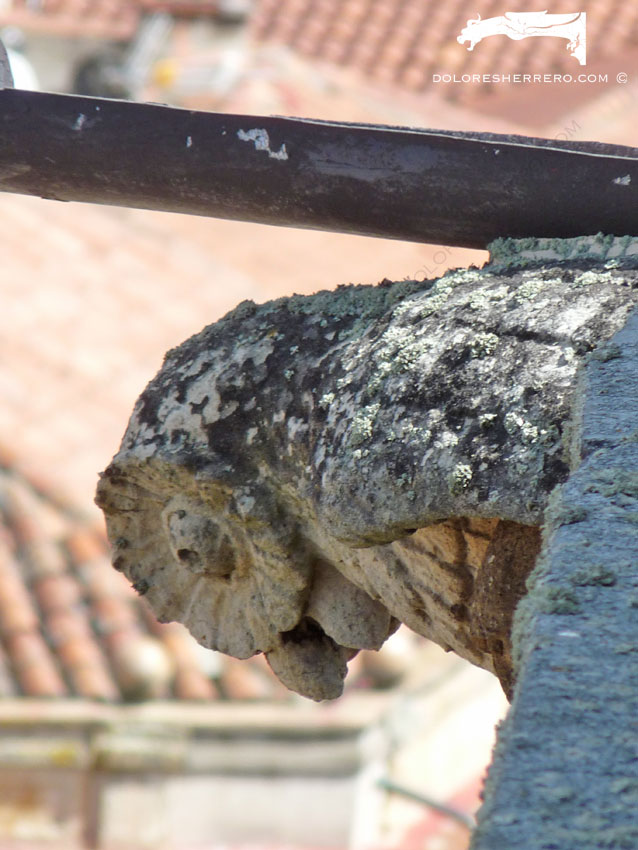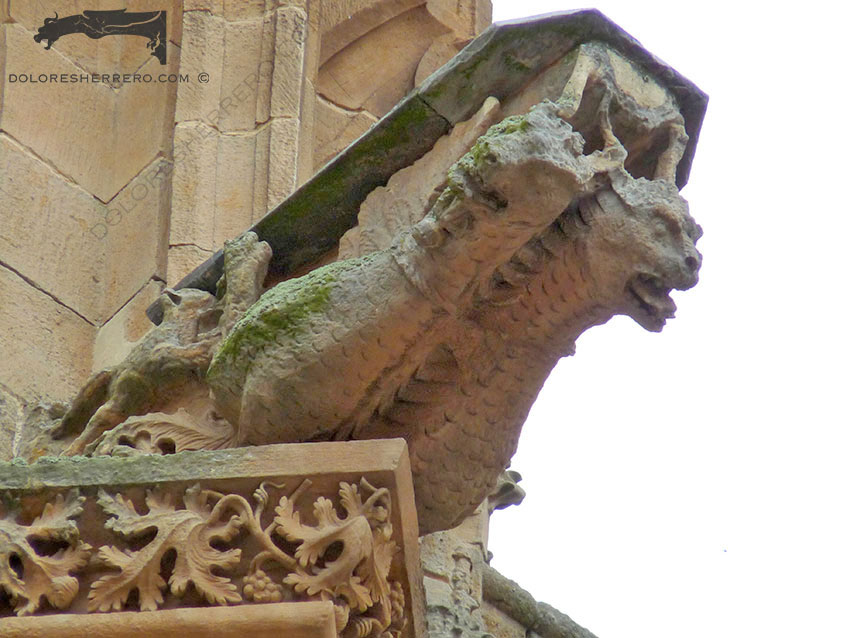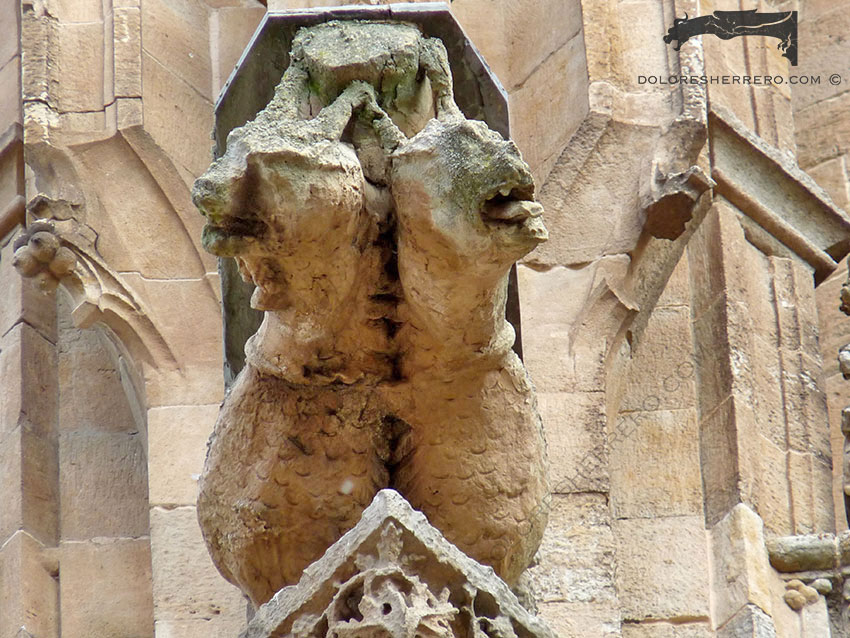Ever since I did my pre-thesis research work on the gargoyles of the city of Salamanca (Spain), I have always been fascinated by the idea of going back to this city and viewing the great number of gargoyles, grotesques and fascinating reliefs on the exteriors of numerous buildings, with countless striking and original creatures and monsters.
In today’s post we are going to start looking at the wonderful and, above all, unique gargoyles of Salamanca Cathedral (Spain). And we are going to start with the gargoyles on the west side of the Catedral Nueva. Most of them have become ornamental, as some of them have had their gutters covered up, while others are deteriorated, and we can see metal drainpipes that replace the gargoyles as a drainage element.
The Gargoyles: A Visual and Iconographic Exploration

The first is a very original gargoyle. It is an animal monster with batrachian legs, wings, ears and a grotesque face. It is located under a large gutter-block.

There are other animal monsters. We see a two-headed dog with fierce-looking heads showing its teeth, very similar to a gargoyle on the north façade. They wear a ribbon or gag in their mouths, as we see in other gargoyles in this cathedral. Another is a winged lion with a ribbon around its neck, an image that can also be seen in the reliefs on the exterior of the cathedral. And the last is a double-headed eagle with a magnificent carving of wings, plumage, tail and heads –an elegant gargoyle, of great beauty and similar in style to another one that we also see in a relief on the outside of the cathedral. Apart from the idea of a two-headed creature, which originates from the god Janus, or of monstrosity, it may also have a meaning of greatness and power: to the left of the central coat of arms, on the façade of the University of Salamanca, there is a shield with a two-headed eagle that alludes to the German empire inherited by King Charles V.
- Grotesque
- Grotesque
There are also some very striking demons. Two of them have the body of quadrupeds, double hooves, protuberances on the genitals and head, horns or ears set backwards, and one has a large flap under the face that forks off and could be a goatee. The hindquarters are excessively high, a characteristic we see in other depictions in the cathedral, for example in the reliefs of the rose window in the interior. The heads are badly worn, so we do not know whether they are human or belong to other creatures.

Rose window
The third demon is a two-headed anthropomorphic demon with a quadrupedal body, hind legs curled up and resting on the body, heads with horns on the sides and human faces with goatees. It has udders hanging down, at which a small, demonic-looking creature is seen suckling. This image not only appears in gargoyles but also in other representations, such as in a relief on the north façade of this cathedral.
- Grotesque
There are also two gargoyles which, while containing the odd element of demonic content, represent two winged dragons with scaly bodies, legs and tails, as well as horns or pointed ears pointing backwards. The heads are terrifying, showing their teeth and tongues. Both are attached by a rope around their necks, which appears to be choking them to judge from the gesture of sticking out their tongues. They have a dorsal crest, and on their feet, we see acanthus-like leaves and demonic creatures on either side.
- New Cathedral of Salamanca (Spain)
- New Cathedral of Salamanca (Spain)
- New Cathedral of Salamanca (Spain)
- New Cathedral of Salamanca (Spain)

Finally, there are three animals. The first is a loving frog with one hand on a large shield decorated with a vase of flowers, and the other on its chest with a very human gesture. It is one of the most curious of Salamanca’s gargoyles. The frog is a symbol of Satan, “unclean spirits like frogs” (Rev. 16:13), and of lust. This rejection not only appears in the Bible, as the Pseudo St. Melito (8th century), in his work The Key, tells: “The frog is the devil”. However, here it has a kindly, even good-natured gesture. It should not be forgotten that in its positive aspect the frog was, for the Egyptian Christians of the first centuries, a symbol of revivification and human resurrection.
The second animal is a magnificently carved, detailed seahorse of great beauty and with a perfect anatomy. In the Greek and Roman world the seahorse is an emblem of the marine element, a tutelary genius and guide of the dead. It is a singular and striking animal in terms of its anatomy. There is a reproduction of these two figures in the museum in the Chapel of Santa Catalina in the cloister.
- Cloister Museum
- Cloister Museum
Finally, there is an owl with a snake coiled around its body, although it could also be a short-toed eagle. It is an amazing gargoyle, in which we see how the snake grips one of the animal’s legs with force, trapping it and giving the impression that it is immobilising the bird in order to seize it. The bird does not fight and remains impassive, which could mean either that it accepts death, or that bird and reptile form a unit, a demonic symbiosis. Let us not forget that the owl, an animal that hides in the dark and fears the light, also symbolises Satan.
Las gárgolas del costado oeste de la catedral salmantina son excepcionales y muy interesantes, tanto por la talla como por la temática. Los demonios son inquietantes y con una gran plasticidad. Son todas gárgolas muy originales y expresivas. Hay que destacar las bellas imágenes de animales como la rana, el caballito de mar y el búho o águila culebrera decorando gárgolas. Quizás relacionado con ello está el interés que estaba surgiendo en el siglo XVI por las ciencias naturales. O puede, como dice Flórez Miguel al hablar de la famosa rana sobre una calavera de la maravillosa fachada plateresca de la Universidad, que sólo se trate de un componente irónico interpretado “desde la risa popular de la farsa”.

Bibliography consulted
CHARBONNEAU-LASSAY, L., El bestiario de Cristo. El simbolismo animal en la Antigüedad y la Edad Media, Palma de Mallorca, José J. de Olañeta, Editor, 1997.
FERGUSON, G., Signs & symbols in Christian Art, New York, Oxford University Press, 1961.
FLÓREZ MIGUEL, C., La fachada de la Universidad de Salamanca. Interpretación, Salamanca, Ediciones Universidad de Salamanca. Historia de la Universidad, 59, 2001.

Doctor of Art History and researcher specializing in the study of gargoyles.
I am Dolores Herrero Ferrio, and my thesis, “An Approach to the Study of Gargoyles of Gothic Cathedrals in Castilla and León”, is dedicated to the study of these fascinating figures.
If you like gargoyles and art history, you will also enjoy my book, “The Gargoyle and Its Iconography,” a book I have written with great care for those interested in the world of gargoyles.
I have created my own Encyclopedia of Gargoyles, a Gargopedia to share with you, where you will discover all the secrets and wonders of these enigmatic sculptures.
I hope you enjoy this Gargopedia as much as I have enjoyed creating it, and remember that each gargoyle has a story to tell, and here you will discover them all.
 The Gargoyles of the University of Alcalá de Henares: A Sculptural Legacy of Madrid, Spain’s Heritage
The Gargoyles of the University of Alcalá de Henares: A Sculptural Legacy of Madrid, Spain’s Heritage The Elusive Gargoyles of the Meirás Towers in A Coruña, Spain
The Elusive Gargoyles of the Meirás Towers in A Coruña, Spain The Gargoyles of Oviedo Cathedral in Spain: Guardians of an Asturian Treasure
The Gargoyles of Oviedo Cathedral in Spain: Guardians of an Asturian Treasure Gargoyles of Cahors Cathedral, France: Moss-Covered and Evocative
Gargoyles of Cahors Cathedral, France: Moss-Covered and Evocative The Gargoyles of the Monastery of Alcobaça: Stone Art in Portugal
The Gargoyles of the Monastery of Alcobaça: Stone Art in Portugal


























